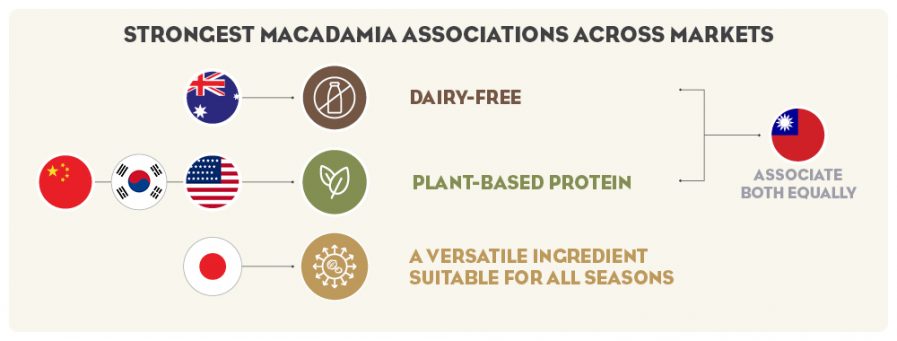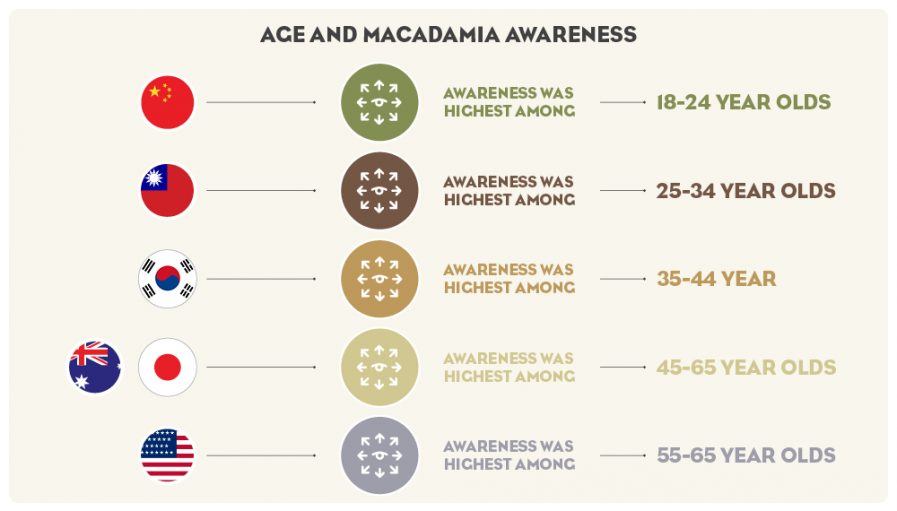The Australian macadamia industry recently completed its largest quantitative consumer insights study to date. Surveying more than 6,000 people in Australia, Japan, China, Taiwan, South Korea and the USA, it took a deep dive into the minds of consumers around the world to uncover current perceptions, expectations and habits around macadamias, food more broadly, and health.

Here we look at how attitudes and beliefs differ between markets to reveal those findings that are universal, where market-specific nuances exist, and where previous research findings were reinforced.
Dairy-free and plant-based protein
When it comes to what consumers have top of mind when they think of macadamias, in most cases it’s either a dairy free ingredient that adds a rich and luxurious flavour to meals or desserts, or their plant-based protein content.
For Australian consumers, the dairy-free association is the strongest, while in China, South Korea and USA, it’s plant-based protein that’s top of mind. Taiwanese consumers associate both equally.
The exception is Japan, where consumers most strongly associate macadamias with their versatility as an ingredient that’s suitable for all seasons.

The luxury nut
Globally, macadamias are regarded by consumers as luxurious, premium and suitable for gifting.
In Australia, Japan, China, Taiwan and USA they’re also regarded as indulgent. Japanese consumers also see them as rich tasting, and Taiwanese consumers regard macadamias as being from trustworthy origins.
In all markets, consuming macadamias made consumers feel more superior and premium than when they consume other nuts. In all markets except South Korea, macadamias also made people feel more special and indulgent. American consumers also said consuming macadamias made them feel more sociable and connected than when they eat other nut types.
Macadamia consumption habits
Downtime dominates consumption occasions
When consumers are enjoying macadamias, it’s usually during a moment of relaxation. This mirrors the consumption moments of most other nuts too, exposing an opportunity for the category to infiltrate work and study occasions that occupy so much of the day.

This finding highlights a strength of macadamias that was identified in consumer insights research conducted in 2018, which revealed ‘relaxation’ as an innovation opportunity space. It found that consumers look for snacks for stress management, as a pick-me-up and for distraction, and they want something enjoyable that won’t induce guilt afterwards. Macadamias fit this requirement perfectly, bringing luxury, elevation and permissibility to snacking.
The social nut
Macadamias outperform other nuts in relation to social consumption occasions such as casual gatherings with family and friends, hanging out and socialising, and celebrations or parties. This was the case particularly in Australia, China, Taiwan and the USA.

Consumer insights research conducted in 2018 revealed that in Western markets, macadamias were well suited to the ‘sharing’ space as they deliver on luxury. Sharing a snacking product with more premium ingredients like macadamias was seen as showing consideration and thoughtfulness. This latest research suggests that three years on, this is becoming the case in Asian markets too.
The top 4 ways macadamias are being consumed
Macadamias are predominantly consumed on their own (58%). This is followed by consumption as a confectionery topping or ingredient (11%), as a bakery topping or ingredient (9%) or as an ingredient in a dish (7%).

Furthermore, macadamias were found to be more likely than other nuts to be consumed in confectionery, bakery or dairy products. This underscores the unique attributes that macadamias were found to bring to the former two categories in research conducted in 2018 and 2019. In these studies, it was revealed that when macadamias are added to any bakery product, they elevate the eating experience, making the product more luxurious, unique, healthy, balanced and desirable. In the chocolate confectionery category, macadamias bring accessible luxury, indulgence, novelty and intrigue as well as a preferable flavour profile when added to chocolate products.
Who consumes more – men or women?
The short answer: it depends. In Australia, Taiwan and the USA, men consume macadamias more frequently than women.
In China consumption every 2-7 days is strong among both men and women, and significantly higher than the global average. In Japan, neither gender dominates daily consumption, but women are more likely to consume weekly. Neither gender is dominating macadamia consumption frequency in South Korea.

How does age affect consumption and awareness?
In all markets, it was consumers under 35 who dominate recent macadamia consumption.
- Australia and China: recent consumption was highest among 18-24 year olds
- Japan, Taiwan, South Korea and USA: recent consumption was highest among 25-34 year olds

Prompted awareness of macadamias was also highest among younger age groups in China and Taiwan, however in all other markets, it was older consumers who demonstrated higher awareness.
- China: awareness was highest among 18-24 year olds
- Taiwan: awareness was highest among 25-34 year olds
- South Korea: awareness was highest among 35-44 year olds
- Australia and Japan: awareness was highest among 45-65 year olds
- USA: awareness was highest among 55-65 year olds

Provenance matters
Consumers globally place importance on macadamia origin. Taiwan and China lead the pack at 94% and 89% respectively. This is followed by South Korea (82%), Australia (80%), Japan (73%) and USA (72%).
90% of Australian consumers rank Australia as one of their most appealing macadamia origins, with 77% ranking it as their #1 choice. In all other markets, more than 50% of consumers nominated Australia as one of their top 3 preferred macadamia origins.



